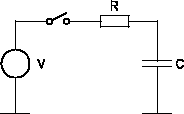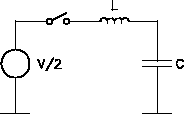|
[Diabatic]

[Adiabatic]

|
As laid out in Section 3.2 each time a capacitance is charged or discharged in a conventional circuit an energy of E = CV2/2 is dissipated, which is the dynamic contribution to the switching energy. The reason why this energy is dissipated is the so-called diabatic switching process, i.e., the electrical subsystem interacts with the thermal subsystem, allowing heat transfer. However, this is not necessarily the case. Especially, when a circuit contains only reactive elements capacitors can be charged and discharged at pleasure without any loss of energy.
The difference is shown in Fig. D.1, where a capacitance C is charged to a voltage V in two different ways.
In the diabatic case the energy delivered by the voltage source isIn a non-ideal circuit, however, capacitors are more or less lossy (most notably interconnections) and the switches have a finite turn-on resistance. In this case the charging of the capacitances has to be carried out in a finite time in order to keep the energy dissipation in the parasitic resistances down.
As shown in Fig. D.2 when the capacitor is charged at a rate of
Practically this means that the application of energy recovery is limited
to special situations, where the ratio of
![]() is affordable like, e.g.,
in the power supply and clocking of the chip or in drivers for external
capacitive loads.
is affordable like, e.g.,
in the power supply and clocking of the chip or in drivers for external
capacitive loads.